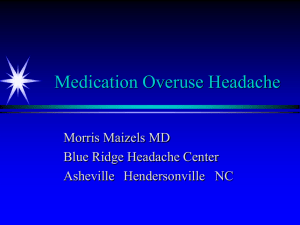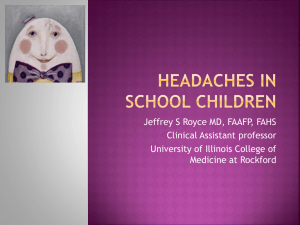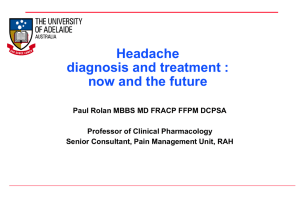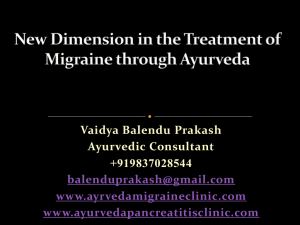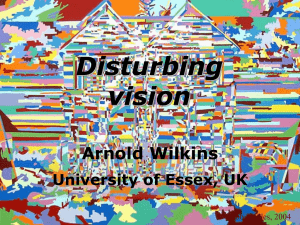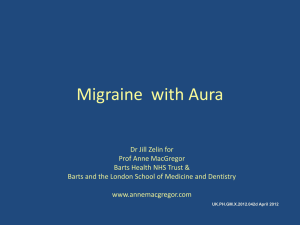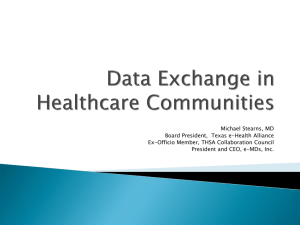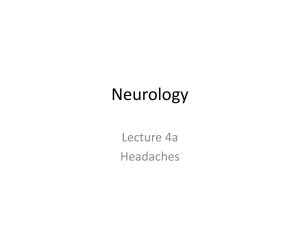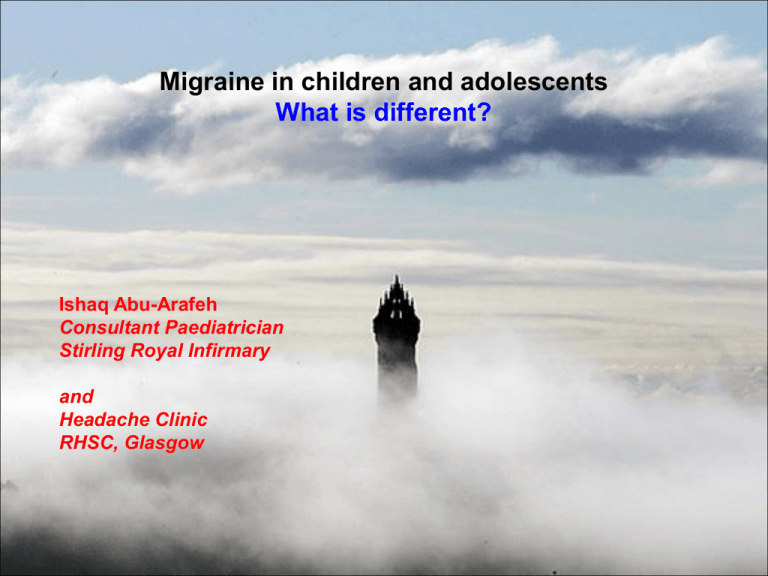
Migraine in children and adolescents
What is different?
Ishaq Abu-Arafeh
Consultant Paediatrician
Stirling Royal Infirmary
and
Headache Clinic
RHSC, Glasgow
1
Headache is common in children and adolescents
2
Prevalence of headache in schoolchildren
100%
≥ 1 headache over 1 year
Migraine
50-70%
80%
10.6%
60%
No headache
Mild headache
Severe headache
Migraine
40%
Chronic TTH
0.9%
20%
Episodic TTH
Several European studies
18-25%
0%
5
6
7
8
9 10 11 12 13 14 15
Age in years
Aberdeen schoolchildren
(Abu-Arafeh and Russell, BMJ, 1994)
3
Headache in specialist clinics
Study
No.
MO
MA
ETTH
CTTH
Other
Abu-Arafeh, McLeod 2005
815
227
39
128
178
243
(27%)
(5%)
(16%)
(22%)
(30%)
86
30
143
Wober Bangol, et al, 1995
437
127
51
Gallai et al 1994
719
176
118
244
181
Jay & Tomassi, 1981
116
42
12
33
29
TOTAL
2087
572
220
699
596
(27%)
(11%)
(33%)
(29%)
4
5
Evaluation of the child with headache:
The Clinical History
Disease and headache
Characteristics
Symptoms during attacks
Anorexia
Duration of illness
Nausea
Frequency of attacks
Vomiting
Duration of each attack
Light intolerance
Severity of pain (interference
with activities)
Location of maximal pain
Quality of pain
Trigger factors
Warning symptoms
Noise intolerance
Pallor
Physical activities
Relieving factors
Symptoms between attacks
6
Evaluation of the child with headache:
The Clinical Examination
General examination should include
• Weight
• Height
• Head circumference
• BP
Neurological examination should include:
• Cranial nerves and optic disc inspection
• Eye movement, nystagmus
• Muscle co-ordination, ataxia, tremor etc.
7
Prospective Headache diary
Name:
Address:
Attack number
Date of birth:
Sex:
1
2
3
4
Date
1 normal activities
2 stop some activities
3 stops all activities
Throbbing, hitting,
banging, Tightness,
pressure, squeeze,
sharp, stab, dull, or
can’t describe
Time started
Time resolved
Severity of headache*
Type of headache**
What may started it?
Any loss of appetite?
Nausea?
Vomiting?
Does light make it worse?
Does noise make it worse?
Is it worse by walking?
Does rest make it better?
Does sleep make it better?
www.bpna.org.uk
Is it better after paracetamol?
8
Excluding brain tumours
Luckily IT IS RARE
1-5 /100,000 children/year
Miltenburg etal. CJNS, 1996
2000-5000/100,000 have migraine
≈1/1000 of children with chronic
headache as the only
symptom, attending a
specialist clinic
Abu-Arafeh & McLeod, ADC, 2005
9
Relationship between headache and brain tumour?
• Almost all children with brain tumour have headache at some
stage
• The vast majority of children with headache have no brain
tumour
• Childhood Brain Tumor Consortium
– 3291 children with brain tumors
– 62% had headache prior to diagnosis
– 98% had > 1 other associated sign or symptom
– >50% had > 3 other associated signs or symptoms
J Neurooncol. 1991
10
Frequency of symptoms in 200 children with brain tumours
Wilne et al, ADC, 2006
11
Associated symptoms in children with headache
Symptom
Headache<4 months
(n = 68)
Headache 4 months
(n = 38)
Vomiting
87%
76%
Vision
53
63
Unsteadiness
49
45
Education /behavioural
37
45
Disturbed sleep
26
31
Growth/fluid balance
7
21
Seizures
7
8
None
0
0
Wilne et al, ADC, 2006
12
So, what are the indications for neuroimaging
13
Indications for Neuroimaging
Features of cerebellar dysfunction: Ataxia
Nystagmus
Intention tremor
Increased intracranial pressure:
Papilloedma
Night/early morning vomiting
Large head
Focal new neurological deficits:
Recent squint
Focal seizures
Personality change
Deterioration in school work
Atypical headaches or migraine
14
Chronic sinusitis and headache
Common misdiagnosis
Sinusitis as detected on
cranial CT scan is mostly a
coincidental finding in
adolescents with chronic
primary headache
Treatment of sinusitis did not
improve headache
Şenbil et al. J headache Pain 2008
15
Childhood Migraine
16
Classification of migraine
ICHD-II, Cephalalgia, 2004
1.1 Migraine without aura
1.2 Probable migraine without aura
1.3 Migraine with aura
1.3.1 Typical aura with migraine
headache
1.3.2 Typical aura with nonmigraine headache
1.3.3 Typical aura without
headache
1.3.4 Familial hemiplegic migraine
1.3.5 Sporadic hemiplegic migraine
1.3.6 Basilar artery migraine
1.5 Childhood periodic syndromes
1.5.1 Cyclical vomiting
1.5.2 Abdominal migraine
1.5.3 Benign Paroxysmal vertigo of
childhood
1.6 Retinal Migraine
1.7 Complications of migraine
1.7.1 Chronic migraine
1.7.2 Status migrainosus
1.7.3 Persistence aura without
infarction
1.7.4 Migraine infarction
1.7.5 Migraine triggered seizures
1.4 Probable migraine with aura
17
Childhood migraine – what is different
Diagnostic criteria, ICHD-II, Cephalalgia, 2004
Migraine without aura
A. At least 5 attacks fulfilling B-D
B. Headache lasting 1-72 in children
C. Headache has at least two of the following characteristics:
1.
Unilateral location
2.
Pulsating quality
3.
moderate or severe intensity
4.
Aggravation by walking or similar routine activity.
D. During headache at least one of the following:
1.
Nausea and/or vomiting.
2.
Photophobia and phonophobia.
18
Childhood migraine – what is different
Reasons for seeking medical advice:
•
Children should not have headache
•
Time lost off school
•
Treatment is not helpful
•
Headache has been going on for a
long time
•
Worry about a serious disease?
19
Childhood migraine – what is different
Duration of migraine attacks
• Variable, but generally
shorter than in adults
• Around 10% of migraine
attacks are less than 2
hours
Abu-Arafeh, Cephalalgia, 2001
20
Childhood migraine – what is different
Site of maximum pain
• Unilateral headache is less
common than in adults
• Frontal headache in at least 50% of
patients
21
Childhood migraine – what is different
Quality of pain
• Allow children to use their own
words
• Most children under the age of 8
can’t describe pain
• Good description of pain can be
expected in majority of children
over 12 years
22
Childhood migraine – what is different
Severity of pain
• best assessed by behaviour during
attacks
• Mild: Does not interfere with activities
• Moderate: Stops some but not all
activities
• Severe: Stops all activities (child lies in
bed)
23
Childhood migraine – what is different
Trigger factors
• None identifiable in the majority of
children
• Food trigger are uncommon
• Missing meals and sleep, stress and
anxiety are likely
24
Childhood migraine – what is different
Mixed headaches:
• Migraine with aura and migraine
without aura can coexist
• 10-20% of patient with migraine
also have tension type headache
25
Childhood migraine – what is different
Associated symptoms:
• Nausea is common in children
(90% of attacks)
• Vomiting is also common and an
early feature (60%)
• Dizziness reported by more than
50% of children with migraine
• Abdominal pain also common
(25%)
26
Childhood migraine – what is different
Migraine with aura
“Alice in wonderland”
•Distorsion of images
•Micropsia
•Macropsia
•Déja vu
27
Childhood migraine – what is different
Response to treatment
• Unpredictable
• Attack to attack variation
• Large placebo effect
28
Principles of pharmacologic treatment
•
As early as possible after onset
of symptoms
•
Most suitable drug
•
Most effective dose
•
Most reliable route of
administration
29
Response to Acute treatment AAN, Neurology, 2004
30
Other drugs used in treatment of acute migraine, but no
clinical studies …..
NSAID
Diclofenac
Mefenamic acid
Apirin (over 15 years age)
Naproxen
Other triptans
Naratriptan
Rizatriptan
Zolmtriptan
Eletriptan
Naramig (GSK)
Maxalt (MSD)
Zomig (Astra Z)
Relpax (Pfizer)
Opiate
Codeine ± paracetamol, aspirin
Meperadine
31
ADC, 2007
Pediatrics, 2005
Neurology, 2004
32
Preventative treatment of migraine, AAN, Neurology, 2004
34
Topiramate trial: Monthly Migraine Days (ITT Population)
Maintenance Phase
Double-Blind Phase
Placebo
(n = 49)
Placebo
(n = 44)
Topiramate
(n = 108)
Topiramate
(n = 95)
0.0
0.0
-0.5
Change -0.5
in Mean -1.0
Monthly
Migraine -1.5
Days*
Change
in Mean
Monthly
Migraine
Days*
-2.0
-2.0
-2.6
P = 0.061
-1.5
-2.0
-2.5
-2.3
-3.0
-2.5
-3.0
-1.0
-3.5
-3.1
P = 0.026
35
*Cochran-Mantel-Haenszel analysis, stratified by number of migraine days at baseline.
Pharmacological prophylaxis
All are DB, XO and placebo controlled studies
Drug
Propranolol
Dose
60-120mg/d
40 mg/d
3 mg/kg/d
No.
28
39
28
Result
less frequency, nausea
No difference
No difference
Pizotifen
1-1.5 mg/d
2.5-3.75 mg/d
39
14
No difference
Fewer symptoms
Flunarizine
5 mg/d
63
Reduced frequency & duration
Clonidine
25-75 mg/d
43
No difference
36
Other drugs used in migraine prophylaxis
•
•
•
•
•
•
•
•
•
•
Magnesium oxide
Sodium Valproate
Gabapentin
Cyproheptadine
Other beta blockers (Atenalol)
Other calcium channels blockers (verapamil)
Vitamin B2
Fever few
Botulinum toxin
Montelukast, etc
37
Childhood migraine – what is different
Childhood Syndromes Related to Migraine
• Benign Paroxysmal Torticollis
• Benign paroxysmal Vertigo
• Cyclical Vomiting Syndrome
• Abdominal Migraine
38
Migraine - “More than a Headache”
Non-headache symptoms
in 200 children with migraine
Limb pains
‘Related’ syndrome
Recurrent limb pains of
childhood
5.5
Dizziness
30.5
Vomiting
attacks
Cyclical vomiting syndrome
4
Abdominal
pain
5
10
15
20
Percent
1
Abdominal migraine
27.5
0
Benign paroxysmal vertigo
25
30
35
39
Psychotherapy:
Useful, regardless of the type of headache
• Physical - behavioural component
• Cognitive therapy
• Behavioural therapy
• Cognitive Behavioural Therapy
40
Alternate or complementary medicine
•
Acupuncture
•
Acupressure
•
Aroma therapy
•
Reflexology
•
Chiropractice
•
Osteopathy
41
Alternate or complementary medicine
42
43
44

